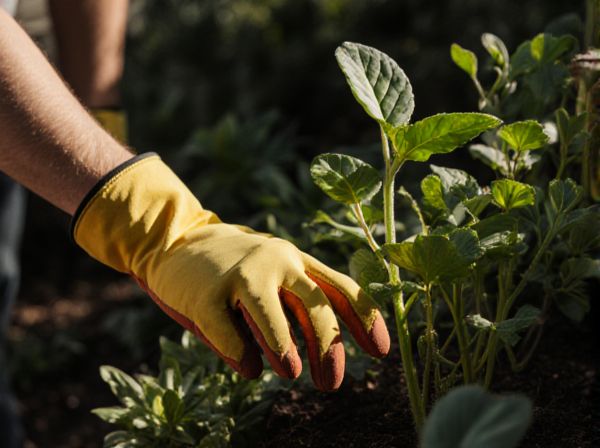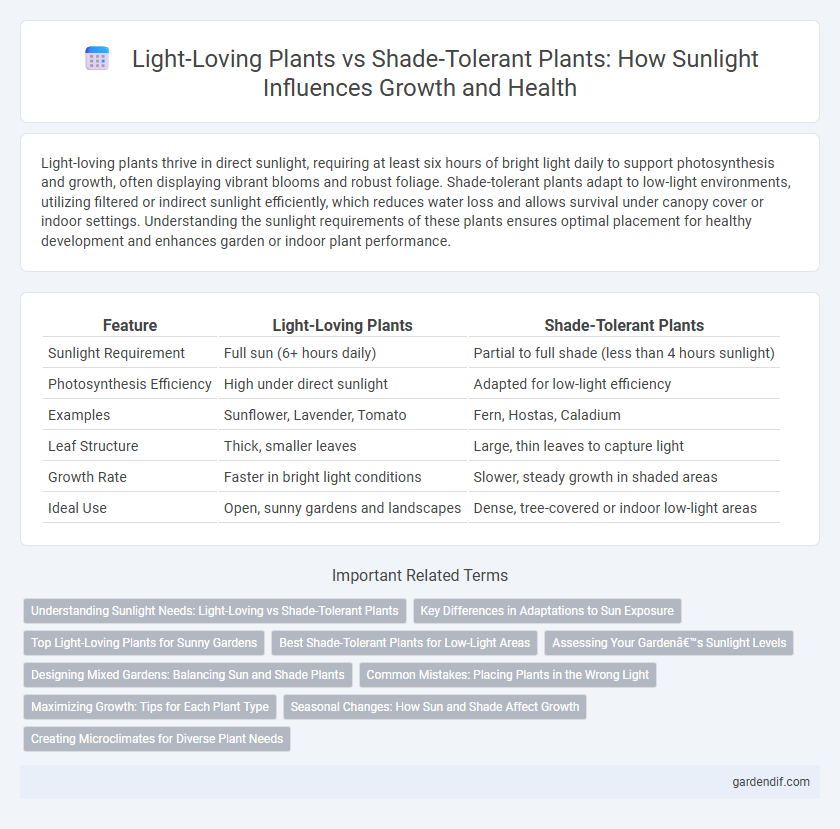
Light-loving plants vs shade-tolerant plants Illustration
Light-loving plants thrive in direct sunlight, requiring at least six hours of bright light daily to support photosynthesis and growth, often displaying vibrant blooms and robust foliage. Shade-tolerant plants adapt to low-light environments, utilizing filtered or indirect sunlight efficiently, which reduces water loss and allows survival under canopy cover or indoor settings. Understanding the sunlight requirements of these plants ensures optimal placement for healthy development and enhances garden or indoor plant performance.
Table of Comparison
| Feature | Light-Loving Plants | Shade-Tolerant Plants |
|---|---|---|
| Sunlight Requirement | Full sun (6+ hours daily) | Partial to full shade (less than 4 hours sunlight) |
| Photosynthesis Efficiency | High under direct sunlight | Adapted for low-light efficiency |
| Examples | Sunflower, Lavender, Tomato | Fern, Hostas, Caladium |
| Leaf Structure | Thick, smaller leaves | Large, thin leaves to capture light |
| Growth Rate | Faster in bright light conditions | Slower, steady growth in shaded areas |
| Ideal Use | Open, sunny gardens and landscapes | Dense, tree-covered or indoor low-light areas |
Understanding Sunlight Needs: Light-Loving vs Shade-Tolerant Plants
Light-loving plants require at least six hours of direct sunlight daily to thrive, developing strong stems and vibrant foliage due to ample photosynthesis. Shade-tolerant plants adapt to lower light conditions, often growing in filtered sunlight or shaded areas, relying on efficient chlorophyll function to maximize energy absorption. Understanding these sunlight needs ensures proper plant placement, promotes optimal growth, and prevents issues like leggy stems or stunted development.
Key Differences in Adaptations to Sun Exposure
Light-loving plants possess adaptations such as thick, waxy leaves and specialized pigments to maximize photosynthesis under intense sunlight, while shade-tolerant plants feature larger, thinner leaves with higher chlorophyll content to capture limited light efficiently. Light-loving species often develop protective mechanisms against UV radiation and heat, including reflective surfaces and sun-tracking movements. Shade-tolerant plants prioritize energy conservation through slow growth rates and efficient light absorption at lower intensities, optimizing survival in shaded environments.
Top Light-Loving Plants for Sunny Gardens
Sunlight plays a crucial role in plant growth, with light-loving plants thriving in full sun conditions and producing vibrant blooms and lush foliage. Top light-loving plants for sunny gardens include lavender, sunflowers, and daylilies, known for their high tolerance to intense sunlight and ability to enhance garden aesthetics. These species optimize photosynthesis under direct sunlight, making them ideal choices for bright, open spaces.
Best Shade-Tolerant Plants for Low-Light Areas
Best shade-tolerant plants for low-light areas include peace lilies, snake plants, and cast iron plants, which flourish without direct sunlight. These species have adapted to photosynthesize efficiently with minimal light, making them ideal for indoor spaces and shaded garden spots. Their resilience and low maintenance requirements contribute to healthier, greener environments in areas with limited natural light.
Assessing Your Garden’s Sunlight Levels
Assessing your garden's sunlight levels is essential for selecting the right plants, as light-loving plants require at least six hours of direct sunlight daily to thrive, while shade-tolerant plants adapt well to areas receiving less than four hours of sun. Using tools like a sunlight meter or observing the garden at different times of day helps determine sun exposure accurately. Properly matching plant species to the garden's light conditions maximizes growth, health, and overall garden success.
Designing Mixed Gardens: Balancing Sun and Shade Plants
Designing mixed gardens requires carefully balancing light-loving plants such as sunflowers and lavender with shade-tolerant species like hostas and ferns to optimize growth and aesthetic appeal. Sunlight exposure, measured in hours per day, determines the placement of each plant to ensure healthy photosynthesis and vibrant foliage. Incorporating soil moisture and microclimate data alongside light intensity levels enhances the success of mixed planting schemes in diverse garden environments.
Common Mistakes: Placing Plants in the Wrong Light
Placing light-loving plants, such as tomatoes and sunflowers, in shaded areas often leads to weak growth and poor flowering due to insufficient sunlight. Shade-tolerant plants like ferns and hostas struggle with leaf scorch and dehydration when exposed to direct, intense sunlight. Matching plants to their ideal sunlight requirements is crucial to prevent stress and ensure healthy development.
Maximizing Growth: Tips for Each Plant Type
Light-loving plants thrive in full sunlight, requiring at least six hours of direct exposure daily to maximize photosynthesis and growth, with species like sunflowers and tomatoes benefiting from well-drained soil and regular watering. Shade-tolerant plants, such as ferns and hostas, adapt to low-light environments by developing broader leaves to capture limited sunlight efficiently, necessitating moist, nutrient-rich soil to support their slower growth rate. For optimal growth, position light-loving plants in south-facing areas and provide shade-tolerant plants with filtered light or dappled shade, ensuring soil conditions align with each plant's specific moisture and nutrient needs.
Seasonal Changes: How Sun and Shade Affect Growth
Light-loving plants thrive in full sunlight, maximizing photosynthesis and growth during longer daylight periods in spring and summer. Shade-tolerant plants adapt to lower light levels by developing larger leaves and slower metabolic rates, enabling survival under canopy cover or during autumn and winter when sunlight diminishes. Seasonal changes influence chlorophyll production and flowering cycles, with sun-loving species flourishing in intense light and shade-tolerant species maintaining steady growth in shaded environments.
Creating Microclimates for Diverse Plant Needs
Light-loving plants thrive in direct sunlight with at least six hours of exposure, requiring well-drained soil and ample warmth to maximize photosynthesis and growth. Shade-tolerant plants adapt to lower light conditions under tree canopies or structures, often benefiting from higher humidity and cooler temperatures. Creating microclimates by strategically positioning both plant types enhances garden biodiversity and optimizes growth conditions suited to their specific sunlight preferences.
Light-loving plants vs shade-tolerant plants Infographic

 gardendif.com
gardendif.com